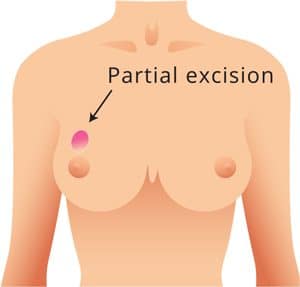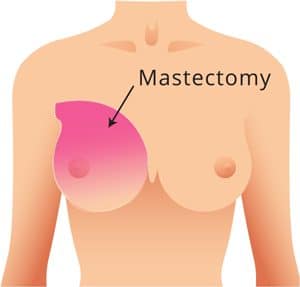
Treatment
After diagnostic tests determine if the abnormal breast tissues e.g. lumps, are either cancerous or non-cancerous (benign), treatment will be initiated accordingly.
For benign lumps, they can be removed by simple and direct procedures. In the case of breast cancer, our specialist will then plan out a customised treatment approach based on your profile and condition.
For ladies seeking breast cancer treatment, take heart in knowing that it is curable and does not always involve removing the whole breast.
Treatment Procedures
1. Benign Breast Conditions
- Minimally-invasive removal
- Surgical removal
2. Individualised Breast Cancer Treatment
-
Chemotherapy
Chemotherapy can be used for selected cases, especially if the cancer is in a single site. When used before surgery, it can potentially shrink the size of the cancer mass by 50%.
If the cancer shrinks adequately, there is then a chance for just partial removal of the breast tissue to clear the cancer. However, a number of criteria must first be met, and additional scans might be required after the treatment.
-
Surgery, including:
-
Breast conservation surgery

 Breast conservation surgery is also known as lumpectomy or wide local excision surgery. For selected cancers, this would be the operation of choice, as only a portion of the breast tissue is removed. The appearance of the breast would thus be generally preserved. It is important to note that all lumpectomies must be followed by radiotherapy. Also, if the size of the cancer is larger than expected, there is a 15-20% chance that a second surgery might be needed.
Breast conservation surgery is also known as lumpectomy or wide local excision surgery. For selected cancers, this would be the operation of choice, as only a portion of the breast tissue is removed. The appearance of the breast would thus be generally preserved. It is important to note that all lumpectomies must be followed by radiotherapy. Also, if the size of the cancer is larger than expected, there is a 15-20% chance that a second surgery might be needed. -
Mastectomy

 This used to be the standard surgery for breast cancer, where all the breast tissue is removed. Thus, it is very unlikely that any radiotherapy will be necessary after the surgery. Also, usually only one surgery is needed to clear all the cancer. However, surgical advancements have created a new option for women – skin-sparing mastectomy, where only the breast tissue and cancer are removed. Thus, the surrounding skin is spared, and the shape and size of the original breast can be preserved. The “space” that remains can then be filled with either an implant or the patient’s own tissue, in a process called reconstruction surgery.
This used to be the standard surgery for breast cancer, where all the breast tissue is removed. Thus, it is very unlikely that any radiotherapy will be necessary after the surgery. Also, usually only one surgery is needed to clear all the cancer. However, surgical advancements have created a new option for women – skin-sparing mastectomy, where only the breast tissue and cancer are removed. Thus, the surrounding skin is spared, and the shape and size of the original breast can be preserved. The “space” that remains can then be filled with either an implant or the patient’s own tissue, in a process called reconstruction surgery. -
Reconstruction (with implants or own tissue)
A breast reconstruction surgery is performed using either an implant or the patient’s own tissue. It can be done during the same operation where the cancer is removed OR later on after the cancer surgery is completed.
A reconstruction that is performed some years after the initial cancer surgery is also known as delayed reconstruction.
-
Treatment FAQs:
Does treatment for breast cancer always involve removing the whole breast?
Breast cancer treatment has certainly advanced significantly over the past 30 years. In the 70’s, the only treatment for breast cancer was radical removal of the breast and muscles of the chest wall. This is probably why many still think that removing the whole breast is the only treatment method.
With current technology, it is now possible to remove only a portion of the breast (lumpectomy) and supplement that with radiotherapy. Other options include giving chemotherapy first to shrink the tumour so that lumpectomy can be performed on a smaller area.
It is also now possible to preserve the breast skin envelope and nipple while removing the cancer and breast tissue, by reconstructing the space underneath with the woman’s own tissue, or with an implant.
There are thus now many options to safely conserve or reconstruct the breast, and not affect the external appearance of the lady after breast cancer surgery.
Is breast cancer curable?
With the advances in breast cancer treatment, including chemotherapy, radiotherapy, hormonal therapy and targeted immunotherapy, most breast cancers are curable if detected early. In fact, cure rates reach as high as 95% for early breast cancers.
The key is to detect them early, as the tumours will still be small and therefore affords more options for surgery.



